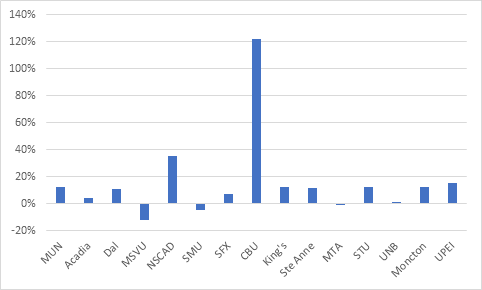Last week, I got an email from the Atlantic Association of Universities. “Great news!” it said. “Enrollment in Atlantic Canadian universities rose by 2.4% last year!” That’s pretty good, I thought to myself, given the demographic crunch and all. So, I clicked through on the document to get to where I can see the institution-by-institution data (I always do this, because it’s always good to see how your clients are doing.)
Hm…OK, NSCAD up 8.3%, that’s good (guess our work there on enrollment is still paying dividends!). King’s up 2% – good for them!…ooo, Mount Allison had a bad year, hope that turns around….UPEI up again, gosh they seem to be on a bit of a roll these days…Cape Breton….Cape Breton…
Figure 1: Change in Full-time Undergraduate Enrolment, By Institution, Atlantic Canada 2017-2018 (aka Cape Breton are you kidding me?)
There is no misprint here. Cape Breton’s full-time undergraduate enrollment rose from 2,213 last year to 3,187 this year – an increase of 44%. I have no words to describe how big a deal this is. I doubt if any university in the country has seen a one-year increase that big in over 40 years.
But, you ask, doesn’t Cape Breton have demographics that look like mainland China, only without the (former) one-child policy? If you graph the youth population of the island, didn’t the numbers fall off a cliff many years ago and never stopped plunging? Why, indeed they did. So where did all these students come from? Better check the visa student numbers.
Figure 2: Change in Full-time Visa Students, By Institution, Atlantic Canada 2017-2018 (aka holy sweet merciful crap Cape Breton are you freaking kidding me???)

Figure 2 tells us two things. First, region-wide, almost everyone is doing pretty well with international student recruitment. But Cape Breton accounts for more than half of the growth in the entire region. And, in fact, international students account for more than 100% of the growth in overall student numbers both at Cape Breton and region-wide. Domestic student enrolments? They are still declining.
My train of thought went immediately to the financial implications. Let’s see….international tuition at Cape Breton is $14,800 this year….so 1,090 new international students means an extra…$16 million in income…check FIUC data to see their total budget numbers for 2016-17…. $61 million, of which only $25 million came from the provincial government…so a 25% budget increase in one year…
It took me awhile to pick my jaw off the floor, but eventually I struggled to my laptop and wrote this piece. In the space of a couple of months, Cape Breton has turned itself from a Canadian institution to one where more than half of its full-time students are international (I’m told if you throw in part-timers who are mostly locals, it’s still 52% Canadian, but still). It’s gone from an institution which is majority-supported by governments to one that is majority-supported by fees; in fact, if we just look at the operating budget, it’s now awfully close to 65% fee-supported. It now gets more money from international students than it does from the provincial government. The implications are breathtaking.
Of course, its not all quite that simple. A flood of international students like that isn’t easy to accommodate. I imagine quite a few classrooms are jammed to overflowing and international student services must be working triple-time. Also, these students can’t all be accommodated on campus, and the Sydney/Glace Bay rental market isn’t set up to cope with an influx like that either. Plus, many of these students will want part-time jobs, which simply won’t be available given the nature of the local economy. The stories about this event won’t all be positive.
But still, Cape Breton University has worked very hard for this kind of opportunity. They have been among the most internationally-focussed institutions in Canada for a decade now. It hasn’t always been easy – they took a hit when the Saudis decided to pull all their King Abdullah scholarship students out a few years ago. But they’ve always been very careful with their income from international students and salted it away rather than let their operating budget get addicted to “easy” income which might disappear one day. My guess is quite a bit of this year’s windfall is going to go to infrastructure on campus – preferably housing so they can make increased student numbers more sustainable.
Small institutions across Canada, especially those in areas of declining enrollment all need to take a hard look at Cape Breton. Because in the current funding environment, it represents the only hope for sustainability. You can go this route, or watch your budget shrink inexorably. That’s the choice.

 Tweet this post
Tweet this post
